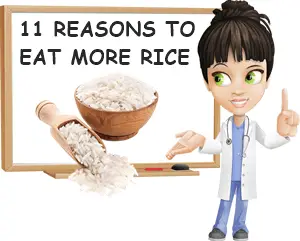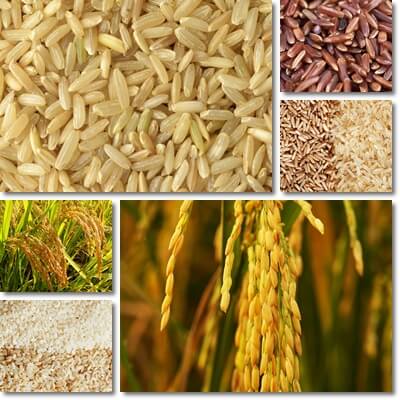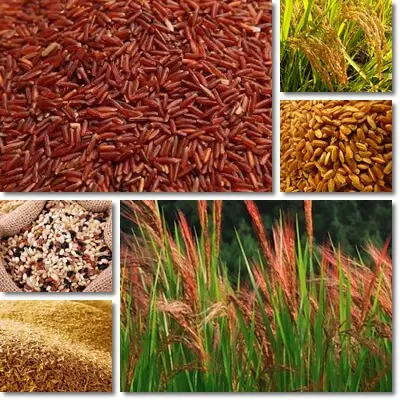Rice is a staple in diets around the world, from normal diets to weight loss diets to diets driven by medical necessity. But with the current focus on healthy and clean eating, rice is being dubbed a nutritionally undesirable food.
And that’s not true at all. All the different types of rice, from refined white rice to the more desirable colorful rice varieties such as brown, red and black rice, can fit right in with any diet.
All rice varieties are high in vitamins, minerals, antioxidants and other important nutrients, except for refined white rice. But even white rice has its place in modern diets and is a source of a number of wonderful benefits for health.
The secret to eating rice and making it a healthy addition to your diet is to choose a variety that is good for you specifically, that is, provides the nutrition you need and/or complies with existing dietary restrictions (e.g. gluten insensitivity, intolerance, allergy).

Just as important, keep to a healthy serving size suited to your individual dietary requirements based on your level of physical activity. That is, you may eat anywhere between 50 to 100 grams of rice per meal (weighed raw), depending on how high your metabolism is, depending on your level of physical activity, whether you are trying to lose weight or gain weight etc. This being said, let’s see what are the top reasons to eat more rice!
1) It’s readily available and cheap
Food availability is important nowadays as so many families struggle to put food on the table. Rice is generally readily available as it’s a major crop cultivated extensively worldwide, so it’s relatively easy to find.
Not just this, but it’s also cheap compared to most other foods, especially if it’s refined white rice.
Generally speaking, rice is a great base for a main meal and makes a great dessert, not to mention it stores well in the fridge for next day leftovers. You can pair it with almost anything: meat, eggs, cheese, all kinds of vegetables, milk and even fresh fruit, dried fruit, nuts, seeds, edible flowers, sugar, maple syrup and honey. Even the least nutritionally desirable of all rice varieties, refined white rice, can be made into a nutritious meal if it’s paired with the right foods, the rice itself providing a solid carbohydrate base for satiation and quick energy.

2) It contributes to balanced nutrition
Refined white rice, which is the most commonly eaten type of rice, is considered a nutritional waste. That is, it’s better to not eat it at all, some voices argue. However, rice in general, including refined white rice, provides essential nutrition in the form of carbohydrates. Carbohydrates are one of 3 major types of macronutrients, the other being protein and fat, and are needed in the diet to achieve macronutrient balance.
Carbohydrates are a source of many benefits for health and carry out important functions in the human body such as providing both quick and long-lasting energy, regulating transit and feeding good gut bacteria for good digestive health that reflects as good general health.
Even refined white rice provides benefits via its carbohydrate content. For example, eating white rice helps feed the brain which relies on simple carbs as its main source of food, and supports intellectual efforts and cognitive functions such as thinking and learning. It’s common for a lot of people to feel they can’t focus or think clearly, and crave carbs. This is something rice can help with!
3) Whole grain rice is a good source of complex carbs
Whole grain rice varieties are good sources of complex carbohydrates. Whole grain rice includes brown rice, which ranks first in terms of nutritional desirability, followed closely by black and purple rice, and red rice varieties. White rice is more of a source of simpler carbohydrates and has a poor dietary fiber content of only about 0.5 grams of fiber per 100 grams of raw grains.
Eating whole grain rice, whether brown, black, purple or red rice, comes with many benefits for health. For example, whole grain rice curbs hunger and stops cravings, helping keep you satiated for hours. It’s actually a good food to eat in a weight loss diet because it releases sugar into the bloodstream slowly and steadily, and has you covered energy-wise until your next meal.
Whole grain rice also regulates digestion and helps nourish digestive flora, improving the health of the gut environment with benefits echoing in other systems and organs, including the immune system and the nervous system. Whole grain rice varieties are also energizing, providing long-lasting energy to support both physical and intellectual activities.
4) Rice can be good for eyesight
Golden rice is a variety of genetically engineered rice that produces beta-carotene. Beta-carotene is a pro-vitamin A antioxidant, that is, a precursor to vitamin A (the body processes it into vitamin A). Eating golden rice helps boost vitamin A levels, with benefits for eyesight.
More specifically, golden rice helps protect the eyes from damaging UV light which helps reduce risks and delay age related macular degeneration causing loss of vision. Carotene antioxidants such as beta-carotene from golden rice and other yellow and orange foods further hold benefits for visual acuity, color vision and vision in low light, dubbed night vision.

5) Black rice is anti-inflammatory
Anthocyanins are pigmented antioxidants with scientifically proven anti-inflammatory activity. Black rice, purple rice and also red rice are all natural sources of anthocyanins, with black rice having the highest content of the pigmented antioxidants. Purple rice, which is actually a variety of black rice, but lower in anthocyanins, hence its color, ranks second in terms of anthocyanin content. Next is red rice.
Studies have identified anthocyanin antioxidants from food as sources of anti-inflammatory benefits, helping lower inflammation levels in the body via their action on inflammatory markers (source).
The permanence of inflammation is conducive to disease, including cardiovascular disease, neurodegenerative disease and even cancer.
Eating colorful foods, especially black, purple and dark red foods can help reduce inflammation levels and promote good overall health.
Black rice, black beans, black cherries, black berries and black carrots, purple rice, purple sweet potatoes, purple grapes, plums and purple carrots, red rice, red cabbage, red sweet potatoes and red berries are all good sources of the anthocyanins.
6) Red rice has cholesterol lowering properties
Red rice is a whole grain rice and a source of antioxidants, dietary fiber and other complex carbohydrates with cholesterol lowering benefits. Red rice helps lower LDL cholesterol (low density lipoprotein) via its content of complex carbohydrates and, at the same time, modestly raises HDL or good cholesterol levels (high density lipoprotein).
Red rice also reduces inflammation at the level of the cardiovascular system, namely inflammation of the endothelium, via its content of anthocyanin antioxidants. A state of permanent inflammation at the level of the cardiovascular system produces endothelial damage and is the starting point of cardiovascular disease (source). By providing anthocyanin antioxidants with proven anti-inflammatory benefits, foods such as red rice contribute to cardiovascular health.
7) Eating rice helps you lose weight
Despite being high in calories and carbohydrates, rice can be an ally in weight loss diets. If you are trying to lose weight, then your focus should be on eating under your daily energy requirements, while consuming foods that are nutritious and energizing, and help you achieve macronutrient balance. And rice can satisfy these requirements even in the limited amounts it can be consumed in a weight loss diet.
Whole grain rice varieties such as red, purple, brown and black rice are high in complex carbs that provide lasting energy and help keep you satiated, even with low intakes suited for weight loss diets (e.g. 50 grams, 60 grams, 70 grams of rice). At the same time, whole grain rice is nutritionally dense, that is, naturally high in essential vitamins and minerals for adequate nutrition, also important in a weight loss diet.
Even refined white rice can be incorporated successfully in a weight loss diet: while not a nutritionally spectacular food, white rice accounts for the carbohydrate part of the diet and helps achieve macronutrient balance. Macronutrient balance is vital for combating hunger and cravings. Eating white rice provides quick energy for the body to use, and helps fill you up and keep you satisfied until your next meal which can easily be 4-6 hours apart.
8) Rice can be good for constipation
Whole grain rice varieties such as red, brown, purple and black rice are good sources of complex carbohydrates, and provide small amounts of dietary fiber.
Complex carbohydrates and indigestible carbohydrates such as dietary fiber maintain digestive health and regulate transit, helping relieve and prevent constipation.
The fact that you don’t typically eat rice by itself also helps. Pairing rice, whether whole or refined, with vegetables or even fruits, adds to your fiber intake and regulates transit time for bowel movements frequency.
9) Rice is good for nausea
Rice has the benefit of being relatively bland tasting – white rice is the very definition of bland food, while brown, red and black rice varieties have only a faint flavor.
Bland foods are good for nausea because they are the only things many people can eat and actually keep down to help them get through a stomach bug, the flu or other instances of nausea.
You can also pair rice with just about anything that you feel can stimulate your appetite just enough to eat something, whether it’s a raw apple grated on top of some bland boiled white rice or a bit of milk added to flavor a black rice pudding.
10) Rice is gluten free
One of the biggest benefits of eating rice is that it’s gluten free. Rice has gluten-like proteins too (these make rice sticky and give risottos their fantastic consistency), but it doesn’t have actual gluten as in wheat gluten. So if you’re sensitive or downright intolerant to gluten, or actually allergic to it, then rice can successfully substitute wheat and other gluten-containing grains in your diet, while providing some semblance of normalcy. Not to mention you don’t have to go out of your way to buy it.
You can choose whole grain rice for the fiber and complex carbs, antioxidants and also vitamins and minerals content, or plain white rice for when you just want a simple carb base to your diet, but still a good pair for everything from meat and vegetables to cheese and fruit.
11) Rice is a nutritionally dense food
Rice is never considered a nutritionally dense food. But that’s just because most people only think about white rice. All other rice varieties, or rice colors, are usually nutritionally dense and contribute heavily to daily nutritional requirements.
For example, brown rice has close to 8 grams of protein per 100 grams of raw grains. It provides around 200% of daily manganese values for an adult, about 40% magnesium and close to 50% phosphorus values, both essential minerals you need for bones and teeth health.
Brown rice is further a good source of dietary selenium which is vital for thyroid health – the thyroid is one of the main regulators of metabolism (think energy levels, sleep quality and weight management), bone density and fertility, especially in women. Brown rice has a good content vitamins B1, B3, B5 and B6 with benefits for energy metabolism, skin health and the nervous system.
Even refined white rice is naturally high in manganese, and has good amounts of selenium, phosphorus, zinc and vitamins B3, B5 and B6. Golden rice is high in pro-vitamin A, while purple and black rice provide both superior nutrition and a high antioxidants content.
